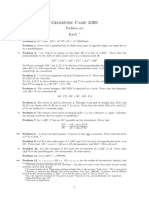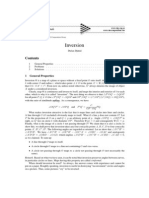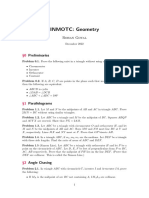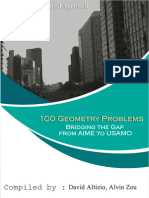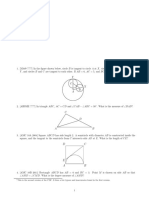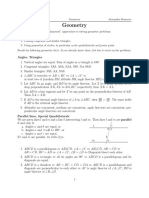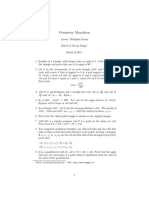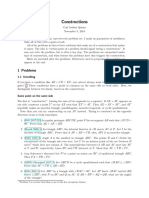Conics and Convexity
Conics and Convexity
Uploaded by
Tim PenCopyright:
Available Formats
Conics and Convexity
Conics and Convexity
Uploaded by
Tim PenOriginal Description:
Copyright
Available Formats
Share this document
Did you find this document useful?
Is this content inappropriate?
Copyright:
Available Formats
Conics and Convexity
Conics and Convexity
Uploaded by
Tim PenCopyright:
Available Formats
266 THE MATHEMATICAL GAZETTE
Conics and convexity
K. ROBIN McLEAN
1. Introduction
In [1], W. D. Munn proved the following result.
Theorem 1: Infmitely many ellipses pass through the four vertices of a
given convex quadrilateral.
Much of the geometry that I studied as an undergraduate in the 1950s
concerned complex projective space, in which convexity plays no part. So I
found Theorem 1 especially piquant and sought to understand it better. This
article is the result. After examining the convexity of quadrilaterals in
general, especially those inscribed in conics, I consider the following
problem. Let P be a variable point in the plane, distinct from the vertices of
a given convex quadrilateral ABCD. It is well known that there is a unique
conic, S (P), through the five points A, B, C, D and P. How does the nature of
this conic depend on the position of P? As a spin-off, we get a very short
proof of Theorem 1. Finally I look at what happens when the quadrilateral
ABCD is not convex. In this case, S (P) is always a hyperbola, but the
distribution of A, B, C and D on its branches is still of interest.
2. When is a quadrilateral convex?
There are many equivalent ways to define convexity for a quadrilateral,
and readers may like to check the equivalence of our definitions. We say that
a set of points, X, in a plane is convex if, for every A, B E X, the whole of the
line segment AB lies in X. A simple polygon, one with no crossings, is convex
if its interior is a convex set, or equivalently if none of its interior angles is
reflex. Finally, a simple quadrilateral ABCD is convex if it is convex as a
polygon, as above, or equivalently if its diagonal line-segments AC and BD
have a point in common. (See Figure 1.) A simple quadrilateral (we shall
consider no others) that is not convex is said to be concave or re-entrant.
o"
C
./
B\PA
D (a) A D (b)
FIGURE 1: (a) A simple convex qudrilateral ABCD. Its diagonal line segments AC
and BD meet at the point O. (b) A simple concave or re-entrant quadrilateral ABCD.
The line segments AC and BD do not meet.
3. Convexity properties of quadrilaterals inscribed in conics
Since opposite angles of a cyclic quadrilateral ABeD add up to 1800, no
https://doi.org/10.1017/S0025557200001303 Published online by Cambridge University Press
CONICS AND CONVEXITY 267
interior angle can be reflex so, by a criterion of the previous section, ABCD
is convex. This is the first of four well-known and easily visualised results:
(l) Any quadrilateral inscribed in a circle is convex.
(2) Any quadrilateral inscribed in an ellipse is convex. (This follows from
(1) because, in a suitable coordinate system, we can map the ellipse
into a circle and back by transformations of the form (x, y) ~ (x, Ay).
These do not affect convexity.)
(3) Any quadrilateral inscribed in a parabola is convex.
(4) Any quadrilateral inscribed in a single branch of a hyperbola is
convex.
Less well known is the following more general result, of which (4) is a
special case:
(5) A quadrilateral inscribed in a hyperbola is convex if, and only if, an
even number of its vertices lie on each branch of the hyperbola.
Examples of each of the three different types of quadrilateral inscribed
in a hyperbola are shown on Figure 2. When all four vertices lie on a single
branch, or when two vertices lie on each branch, the quadrilateral is convex,
as in (a) or (b). When three vertices lie on one branch and one vertex lies on
the other branch, as in (c), the quadrilateral is concave.
) ~~ It (a) (b)
HaVRE 2: Qudrilaterals inscribed in a hyperbola.
(c)
All these results can, if desired, be proved algebraically. For example, to
prove (5), take the asymptotes as oblique axes (see, for example, [2, p.108]).
Then, with suitable scaling, we may let the hyperbola have parametric
equations x = t, Y = 1 I t with A, B, C, D given by t = a, b, e, d
respectively. The diagonal AC has equation x + aey = a + e. Let the point
of intersection, 0, of AC and BD divide BD in the ratio /1 : A and AC in the
ratio /1' : A'. Then 0 is
Ab + Ild, A(llb) + /1(1ld)).
(
A+/1 A+/1
It is easy to verify that substituting this into the equation of AC gives
A b (d - a)(d - e)
- = (1)
/1 deb - a)(b - e)
Similarly, swapping a with b and e with d,
A' a(e - b)(e - d)
(2)
/1' e(a - b)(a - d)
https://doi.org/10.1017/S0025557200001303 Published online by Cambridge University Press
268 THE MATHEMATICAL GAZETTE
From (1) and (2),
A A' ab(d - d (3)
Ii Ii' cd (b - af·
If ABCD is convex, then 0 lies on both line segments AC and BD, so that
M' 1!JIl' > O. By (3), this means abl cd > 0, so that an even number of
vertices of the quadrilateral lie on each branch of the hyperbola. To reverse
the argument, note that we assume ABCD to be simple so, if M' 1!JIl' > 0,
then Alii > 0 and A'Iii' > O.
4. How does the conic S (P) depend on P?
Turning to the problem posed earlier, let the diagonals AC and BD of the
~ ~
given convex quadrilateral ABCD meet at O. Choosing OA, OB as the
positive directions along oblique axes Ox, Oy, we let A be (a,O) and B be
(0, f3), where a, f3 > O. Since ABCD is convex, C and D have the forms
(-y,O) and (0, -l5) respectively for some y, l5 > O. The conic
S == (Jl5(x - a)(x + y) + ay(y - (J)(y + l5) + a(Jyl5 = 0 (4)
clearly goes through A, B, C, D as does the line pair xy = 0 and any conic
of the form S + 2hxy = O. Now S + 2hxy = 0 is an ellipse if, and only if,
a(Jyl5 > h2• So if flo = .ja(Jyl5, then for each of the infinitely many values
of h in the range -ho < h < ho we get an ellipse through A, B, C, D, giving
a proof of Theorem 1.
Next, write S, == S + 2hoxy = 0 and S2 == S - 2hoxy = 0,
each of which is a parabola or a parallel line pair. In the regions where
xy > 0, we have
Sl > S + 2hxy > S2,
so that if (x, y) is on the ellipse S + 2hxy = 0, then at (x, y), Sl > 0 > S2,
which says (x, y) is outside SI and inside S2. For xy < 0 the inequalities,
and the conclusions, are reversed.
Figure 3 shows the general situation when ABCD is not a trapezium. In
this case Sl and S2 are parabolas, indeed the only parabolas of the pencil of
conics through A, B, C and D. The three line-pairs and two parabolas of this
pencil separate the real projective plane (see [3]) into 20 regions, numbered
in Figure 3, each having precisely two of the vertices A, B, C, D on its
boundary. Each of the other conics of the pencil passes through exactly four
of these 20 regions in a predetermined cyclic order. So our 20 regions can be
partitioned into five 4-cycles as follows:
A B 0 C
~ 2 ~ 3 ~ 4 ~
A B C 0
5 ~ 6 ~ 7 ~ 8 ~ 5
A C B 0
9 ~ 10 ~ 11 ~ 12 ~ 9
A 0 C B
13 ~ 14 -7 15 ~ 16 ~ 13
A B C 0
17 ~ 18 ~ 19 -7 20 ~ 17
https://doi.org/10.1017/S0025557200001303 Published online by Cambridge University Press
CONICS AND CONVEXITY 269
FIGURE 3: The three line-pairs and two parabolas through the vertices of a convex
quadrilateral ABeD divide the real projective plane into 20 regions. Each of the
regions 14, 16, 18 and 20 is bounded by an arc of a parabola and a straight line
segment and is too thin to be easily visible in this figure.
The first cycle indicates that any conic of the pencil that passes into
region 1 must go through A into region 2, then through B into 3, via D into 4
and via C back into region 1. Regions 1 and 3 cross the line at infinity.
Moreover, in going from 1 to 3 the conic passes through A and B, whilst in
returning from 3 to 1 it passes through D and C. So if P lies in any of the
four regions of this first cycle, then the conic S (P) is a hyperbola with A and
B on one branch and C and D on the other branch. Readers can use similar
arguments to check that when P lies in a region of the fourth or the fifth
cycle, S (P) is a hyperbola with A, B, C and D on the same branch and that
when P lies in a region of the third cycle, S (P) is a hyperbola with A and D
on one branch and Band C on the other. No region in the second cycle
crosses the line at infinity, although regions 5 and 6 extend to infinity and
each has one infinite point on its boundary. So when P lies in any second
cycle region, S (P) is an ellipse.
In the special case when ABCD is a trapezium, but not a parallelogram,
we may suppose that AB is parallel to CD. One of the two parabolas of the
pencil now degenerates to this parallel line-pair and we lose a complete
cycle of regions (the fifth) from Figure 3.
When ABCD is a parallelogram, there are no parabolas in the pencil and
a further cycle of regions (the fourth in our list) disappears, leaving the 12
regions shown in Figure 4 that constitute the first three of our original 4-
cycles.
https://doi.org/10.1017/S0025557200001303 Published online by Cambridge University Press
270 THE MATHEMATICAL GAZETTE
AGURE4: The three line-pairs through the vertices of a parallelogram divide the real
projective plane into 12 regions.
FIGURE5: The three line-pairs through the vertices of a concave quadrilateral
divide the real projective plane into 12 regions.
5. Concave quadrangles
When the quadrilateral ABCD is concave, it can have no circumscribing
ellipses or parabolas, so every non-degenerate conic through its vertices
must be a hyperbola. Moreover three vertices must lie on one branch whilst
one vertex, which I shall call isolated, lies on the other branch. Since ABCD
https://doi.org/10.1017/S0025557200001303 Published online by Cambridge University Press
CONICS AND CONVEXITY 271
is concave, one of its vertices lies inside the triangle formed by the other
three vertices. This interior vertex (denote it by A) cannot be isolated for, by
continuity, the branch through A must cut at least one of the sides (say BC)
of the surrounding triangle BCD, and it must do so at either B or C, for
otherwise BC would meet the hyperbola in three distinct points. The six
lines AB, AC, AD, BC, BD and CD divide the real projective plane into 12
regions. (See Figure 5.)
As in the convex case, these 12 regions fall into 4-cycles:
A C B D
~ 2 ~ 3 ~ 4 ~
A DeB
5~6~7~8~5
A B D C
9 ~ 10 ~ 11 ~ 12 ~ 9
In the first cycle, regions 3 and 4 cross the line at infinity. The point B is
the common boundary of these regions so, if P is a point in any region of the
first cycle, then the conic S (P) is a hyperbola with B isolated on one branch
whilst A, C and D lie on the other branch. Similarly when P lies in a region
of the second cycle, C is isolated and, when P lies in a third cycle region, D
is the isolated vertex.
Figure 6 shows some of the conics of the pencil through A, B, C and D.
All are hyperbolas or line-pairs, as predicted.
FIGURE 6: Three of the hyperbolas that pass through the vertices of a concave
quadrilateral. Each corresponds to one of the the three 4-cycles identified in the text.
Acknowledgements
I am grateful to Professor Peter Giblin for interesting discussions and
for showing me how Cinderella software (see [4]) can be used in visual
exploration of what happens to the unique conic through five points, A, B, C,
https://doi.org/10.1017/S0025557200001303 Published online by Cambridge University Press
272 THE MATHEMATICAL GAZEITE
D and P when P is dragged around the screen whilst the other four points
remain fixed.
The referee deserves special mention for commenting on earlier
versions of this article so fully and helpfully. As a result, several arguments
have been improved and new ones suggested. In particular, the observation
in §§4 and 5 that regions fall into 4-cycles is due to the referee, who also
unearthed an 1847 article ([5]) containing essentially the same argument as I
used in the first part of §4.
I would also like to thank the Editor for his patience in allowing me so
much time for revising the article.
Dedication
I never knew Douglas Munn but, from what I have read ([6, 7, 8]), he
was a fine teacher. Many readers of the Gazette have been fortunate to have
such teachers. So I would like to dedicate this article to the memory of those
who taught me mathematics at Bradford Grammar School and whose
example led me to become a teacher myself: Margaret Baker, from whom I
first learned about congruent triangles; Walter Thornton, from whom I
learned about pencils of conics; and Keith Turner, who once showed us
seven different solutions to a Cambridge Scholarship geometry problem and
who inspired so many of his pupils.
References
1. W. D. Munn, Ellipses circumscribing convex quadrilaterals, Math. Gaz.
92 (November 2008) pp. 566-568.
2. H. S. M. Coxeter, Introduction to geometry (2nd edn.), John Wiley &
Sons (1969).
3. H. S. M. Coxeter, The real projective plane (2nd edn.), Cambridge
University Press (1955).
4. P. J. Giblin, Review of Cinderella (Version 1.2) interactive geometry
software, Math. Gaz. 85 (July 2001) pp. 364-366.
5. S. Fenwick, On the plane quadrilateral, The Mathematician, Vol.lI,
No.6 (July 1847) pp. 285-295, also available at
http://books.google.co.uklbooks?id=59YLAAAAYAAJ&pg=PA285.
6. Scotsman Newspapers Limited, Douglas Munn (12 November 2008),
available at http://thescotsman.scotsman.com!obituaries!Professor-
Douglas- Munn.468381 O.jp
7. J. M. Howie, Tribute to Douglas Munn, Semigroup Forum 59 (1999)
pp.I-7.
8. N. R. Reilly, Walter Douglas Munn 1929-2008, Semigroup Forum 78
(2009) pp. 1-6.
K. ROBIN McLEAN
Department of Mathematical Sciences, University of Liverpool, Liverpool
L697ZL
https://doi.org/10.1017/S0025557200001303 Published online by Cambridge University Press
You might also like
- Solving Problems Involving Special Parallelogram: Quarter 3Document10 pagesSolving Problems Involving Special Parallelogram: Quarter 3Mark Julian CadapanNo ratings yet
- Inversion 5Document3 pagesInversion 5Mohammed ImranNo ratings yet
- DLL Special Right TrianglesDocument9 pagesDLL Special Right TrianglesPatrick Guerra100% (1)
- Geometry Camp 2009: Problem SetDocument7 pagesGeometry Camp 2009: Problem SetMahmudNo ratings yet
- The Complete Quadrilateral and Its PropertiesDocument14 pagesThe Complete Quadrilateral and Its PropertiesDaniel RamosNo ratings yet
- Three Geometry Lemmas PDFDocument7 pagesThree Geometry Lemmas PDFAlex YuNo ratings yet
- Vectors - Applications To Problem Solving: Berkeley Math Circle 2000-2001Document4 pagesVectors - Applications To Problem Solving: Berkeley Math Circle 2000-2001Kamran MehdiyevNo ratings yet
- Inversion in The Plane. Part II: Radical Axes: BERKELEY MATH CIRCLE, October 18 1998Document10 pagesInversion in The Plane. Part II: Radical Axes: BERKELEY MATH CIRCLE, October 18 1998hodgeheg9991234No ratings yet
- 21 Cyclic Quadrilaterals: 21.1 Angles in A CircleDocument14 pages21 Cyclic Quadrilaterals: 21.1 Angles in A CircleAndre Swaggerific PickettNo ratings yet
- Projective GeometryDocument9 pagesProjective GeometryccllNo ratings yet
- Conic Ho DgoDocument9 pagesConic Ho DgoBubu DroidNo ratings yet
- Inversion: 1 General PropertiesDocument5 pagesInversion: 1 General PropertiesNguyễn Lâm ThịnhNo ratings yet
- IMOMATH - Inversion in GeometryDocument5 pagesIMOMATH - Inversion in GeometryDijkschneier100% (2)
- Cyclic quadrilaterals handout 2Document2 pagesCyclic quadrilaterals handout 2kiaradfadaeihaghiNo ratings yet
- Projg ML Milivoje LukicDocument10 pagesProjg ML Milivoje LukicPh HuyamNo ratings yet
- 5 21 PDFDocument17 pages5 21 PDFKim ChiNo ratings yet
- Hagge Circles RevisitedDocument17 pagesHagge Circles Revisitedmoka0687No ratings yet
- 02 YellowDocument4 pages02 YellowolziichNo ratings yet
- FG 201007Document13 pagesFG 201007cloz54No ratings yet
- Geometry Marathon - MathlinksDocument67 pagesGeometry Marathon - MathlinksAltananyNo ratings yet
- Fin 2021 SolDocument22 pagesFin 2021 SolCyka BlyatNo ratings yet
- Synthetic Proofs of Two Theorems Related To The Feuerbach PointDocument8 pagesSynthetic Proofs of Two Theorems Related To The Feuerbach PointDũng Nguyễn TiếnNo ratings yet
- Fin 2023 SolDocument25 pagesFin 2023 SolCyka BlyatNo ratings yet
- Affine GeometryDocument2 pagesAffine GeometryLara JakićNo ratings yet
- 2 EuclidDocument25 pages2 EuclidLorie Mae MicarisNo ratings yet
- INMOTC GeoDocument12 pagesINMOTC Geosreepranad DevarakondaNo ratings yet
- 9th Introductions To Euclid Geometry Test Paper-1Document8 pages9th Introductions To Euclid Geometry Test Paper-1vishal_bokaroNo ratings yet
- 100 Olym Geo Problems SolutionsDocument35 pages100 Olym Geo Problems SolutionsNew Hero I100% (1)
- 100 Geometry ProblemsDocument8 pages100 Geometry ProblemsShrihan SuchitNo ratings yet
- Incircles and Circumcircles New PDFDocument9 pagesIncircles and Circumcircles New PDFAniketNo ratings yet
- Recurring Crux Configurations 6 OI Parallel Side 38.4Document4 pagesRecurring Crux Configurations 6 OI Parallel Side 38.4ŁØNɆ ⱲØŁꞘNo ratings yet
- Conic CubicDocument11 pagesConic CubicAryan SinghNo ratings yet
- MC Geometry PDFDocument4 pagesMC Geometry PDFสฮาบูดีน สาและNo ratings yet
- Trigonometry Handout For RMO or BMO 1Document13 pagesTrigonometry Handout For RMO or BMO 11sherlock1.homesrNo ratings yet
- 92a506adc10f5d3dc1dbe7658d73c1d8Document14 pages92a506adc10f5d3dc1dbe7658d73c1d8Hanirutha.M 7BNo ratings yet
- Ch8._WorksheetDocument3 pagesCh8._Worksheetshweta RathiNo ratings yet
- Geometric Characterizations of The Cross Ration in A Pencil of ConicsDocument18 pagesGeometric Characterizations of The Cross Ration in A Pencil of ConicsAlexsandro Dos Santos LimaNo ratings yet
- GeolemmasDocument10 pagesGeolemmasddkillerNo ratings yet
- 02 Concur SolnDocument2 pages02 Concur SolnolziichNo ratings yet
- Maths Arsi Model IVDocument7 pagesMaths Arsi Model IVAbdulmelik MameNo ratings yet
- Geometry Marathon MathlinksDocument33 pagesGeometry Marathon MathlinksTahaNo ratings yet
- VectoriDocument22 pagesVectoriStefan LucianNo ratings yet
- Circles, Tangent-Chord Theorem, Intersecting Chord Theorem and Tangent-Secant TheoremDocument11 pagesCircles, Tangent-Chord Theorem, Intersecting Chord Theorem and Tangent-Secant TheoremStefanie BargoNo ratings yet
- For Entry at XI STDDocument40 pagesFor Entry at XI STDnikhbiradarNo ratings yet
- Vibrant Academy: VG SirDocument3 pagesVibrant Academy: VG SirArman SinghNo ratings yet
- EuclidDocument27 pagesEuclidJames MlotshwaNo ratings yet
- BSED MATH 8: Modern Geometry Hilbert's AxiomDocument89 pagesBSED MATH 8: Modern Geometry Hilbert's Axiomjoedskie2801No ratings yet
- Constructions: 1 ProblemsDocument9 pagesConstructions: 1 ProblemsTanmayNo ratings yet
- Sharygin 2013Document16 pagesSharygin 2013Đào Quang ĐứcNo ratings yet
- IGO2016Document29 pagesIGO2016denisNo ratings yet
- Inversion in The Plane - Zvezdelina Stankova 2004 PDFDocument11 pagesInversion in The Plane - Zvezdelina Stankova 2004 PDFThanos KalogerakisNo ratings yet
- (Solutions) Sharygin Geometry Mathematical Olympiad 2018 (Correspondence Round)Document13 pages(Solutions) Sharygin Geometry Mathematical Olympiad 2018 (Correspondence Round)Võ Trần Ngọc HữuNo ratings yet
- IMO Training 2007 Lemmas in Euclidean Geometry Yufei ZhaoDocument10 pagesIMO Training 2007 Lemmas in Euclidean Geometry Yufei ZhaoAnonymous AjEkeHz5RNo ratings yet
- The Incenter/Excenter Lemma: August 6, 2016Document4 pagesThe Incenter/Excenter Lemma: August 6, 2016johnsonNo ratings yet
- Xiii Geometrical Olympiad in Honour of I.F.Sharygin The Correspondence Round. SolutionsDocument13 pagesXiii Geometrical Olympiad in Honour of I.F.Sharygin The Correspondence Round. Solutions89a12 Nguyễn Lã Trọng NguyênNo ratings yet
- Projective Geometry ContinuedDocument5 pagesProjective Geometry ContinuedLuis FerroniNo ratings yet
- Hyperbolic Functions: with Configuration Theorems and Equivalent and Equidecomposable FiguresFrom EverandHyperbolic Functions: with Configuration Theorems and Equivalent and Equidecomposable FiguresNo ratings yet
- Y7 Autumn Block 5 WO10 Represent Any Fraction As A Diagram 2019Document2 pagesY7 Autumn Block 5 WO10 Represent Any Fraction As A Diagram 2019rayahalsawafiriNo ratings yet
- Trig1 (Compound Angles) (TN)Document13 pagesTrig1 (Compound Angles) (TN)Raju Singh100% (1)
- Exam Questions CirclesDocument48 pagesExam Questions Circlesuroosahka2007No ratings yet
- The Triangle Theorem.a .EDocument2 pagesThe Triangle Theorem.a .ESwapnil JagtapNo ratings yet
- Maths Class 7Document20 pagesMaths Class 7Umair SaudNo ratings yet
- 02. G8 Math Geometry FinalModel Al.adwaa Answers T1 2025Document10 pages02. G8 Math Geometry FinalModel Al.adwaa Answers T1 2025Sherif SolimanNo ratings yet
- 11-4 Inscribed AnglesDocument15 pages11-4 Inscribed AnglesNielle ArtiagaNo ratings yet
- MATH 2044 LONG QUIZ 1 1say2425Document2 pagesMATH 2044 LONG QUIZ 1 1say2425johnmarcbolpendaNo ratings yet
- 4-Angles in A TriangleDocument3 pages4-Angles in A TriangleNIVAAN DHINGRANo ratings yet
- MHF4U - Unit 2 - Version ADocument44 pagesMHF4U - Unit 2 - Version AhayatNo ratings yet
- IMSO 17th Math Short AnswerDocument7 pagesIMSO 17th Math Short Answerhoangbichthuy.thanhtriNo ratings yet
- Shapes and Geometric ReasoningDocument25 pagesShapes and Geometric ReasoningkatyaNo ratings yet
- Chapter 7 SimilarityDocument42 pagesChapter 7 SimilarityjujuNo ratings yet
- Pythagoras Theorem LessonDocument3 pagesPythagoras Theorem LessonCruashai GTANo ratings yet
- Team Dewey Refresher 2Document32 pagesTeam Dewey Refresher 2Maria Lourdes OndayNo ratings yet
- Kelly - Geometry MediumDocument53 pagesKelly - Geometry MediumMy Duyen NguyenNo ratings yet
- Mid-Term MandyaDocument4 pagesMid-Term MandyaRekha DushyanthNo ratings yet
- Complex Number (Question Paper) - JEE LevelDocument4 pagesComplex Number (Question Paper) - JEE LevelparassethNo ratings yet
- TRIGONOMETRYDocument28 pagesTRIGONOMETRYMyrlanBarrerasNo ratings yet
- Design Solid 3Document32 pagesDesign Solid 3luongnguyendinhNo ratings yet
- KZN Math T12020 EucliGeo & Trig SplittedDocument19 pagesKZN Math T12020 EucliGeo & Trig SplittedBen MukebaNo ratings yet
- 20 Angles Triangles and PolygonsDocument21 pages20 Angles Triangles and PolygonspunnavithpeterNo ratings yet
- Grade 9 Test QuestionsDocument4 pagesGrade 9 Test QuestionsAllen Dave PahanguinNo ratings yet
- Algebra, Claculus, Trig Exam Online-1Document5 pagesAlgebra, Claculus, Trig Exam Online-1wr4sx6tsgpNo ratings yet
- Lesson Plan in Math 9Document3 pagesLesson Plan in Math 9marie padolNo ratings yet
- Math Quiz Bee - ReviewerDocument19 pagesMath Quiz Bee - ReviewerJessa FerrerNo ratings yet
- #Cdba/S: J (UV ( - MZH$)Document23 pages#Cdba/S: J (UV ( - MZH$)atharvbhadoriya43No ratings yet
- Trigonometry 11th Edition Lial Solutions ManualDocument55 pagesTrigonometry 11th Edition Lial Solutions ManualjohnkimisntmqeadxNo ratings yet



